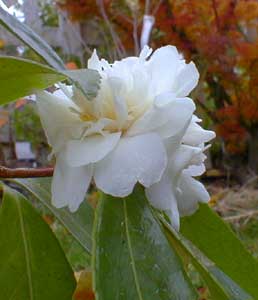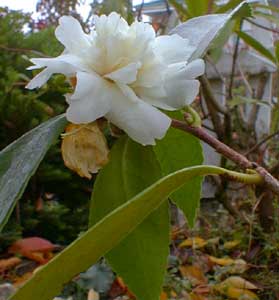
'Snow Flurry' Camelia
"Camelias fall whole from branches. Even upon the soil, their beauty is entrancing. They are like the love affairs of court women."
-Lady Murasaki Shikibu,
paraphrased from the Tale of Genji
paraphrased from the Tale of Genji
This hybrid camellia's cultivar name 'Snow Flurry' is not merely for its whiteness or for its blooming in Autumn & Winter, but aludes also to its improved cold-hardiness. The majority of camellias can be difficult outside of such ultra-mild temperate zones as we experience on Puget Sound, but 'Snow Flurry' has been tested at minus ten degrees Fahrenheit without suffering damage, so it can be successfully gardened down to zone 6.
The 1986 release was hybridized & developed by the National Aboretum with the goal of increasing how far north camellias can be gardened. Of its parents, C. oleifera is a small-flowering Chinese native that has been used in many hybrid programs to increase cold-hardiness of showier species. The Tea-Oil Camelia C. oleifera which provided half its heritage is currantly believed to be a natural hybrid between C. sasanqua & C. japonica.
 This was crossed with 'Frost Princess,' a 1981 hybrid with lavender-pink double-flowers, itself notably cold-hardy. 'Frost Princess' was also developed by Dr. William Ackerman & the National Arboretum, as a cross between a rose-pink double C. hiemalis 'Bill Wylam' & a red semi-double C. heimalis 'Shishigashira' (also rendered as two words 'Shishi Gashira' sometimes hyphenated, & synonymous with 'Beni-Kan-Tsubaki').
This was crossed with 'Frost Princess,' a 1981 hybrid with lavender-pink double-flowers, itself notably cold-hardy. 'Frost Princess' was also developed by Dr. William Ackerman & the National Arboretum, as a cross between a rose-pink double C. hiemalis 'Bill Wylam' & a red semi-double C. heimalis 'Shishigashira' (also rendered as two words 'Shishi Gashira' sometimes hyphenated, & synonymous with 'Beni-Kan-Tsubaki').The resulting 'Snow Flurry' had none of the color of the parents, but all the cold-hardiness & the extra flower petals. Each bloom averages three & a half inches, with twelve petals plus eight petaloids.
The flowers are both Peony-form meaning fully double rounded blooms with irregular petals, & Anemone-form indicating many extra out petals lending it a flatter flower sometimes even convex in the center. The two portraits on this page were taken in November, & show one each of a fully round Peony & a somewhat flattened Anemone blooms, on the same shrub. Though I've read in catalogs that this is a scented camellia, I can detect no such perfume.
It's a broadleaf evergreen of surprising vigor, sometimes a little floppy if not trained to an espalier, but striving to be upright & arching. It could become increasingly rangy without occasionally pruning for form. Pruning is for looks only, & would be done when autumn blooms are finished, before it starts setting new buds for the following autumn display.
It likes bright shade or an otherwise protected area where it won't suffer from too much wind & sun, though too deep a shade will keep it from blooming. Naturally acidic soil is best; camellias don't care for soils that have been often amended artificially. Drought-tolerance is low, although once it is well established, occasional bouts of dryness won't kill it. It is forgiving of maritime salt-spray conditions, hence a perfect coastal shrub. Propogation is from cuttings taken in late fall for rooting.